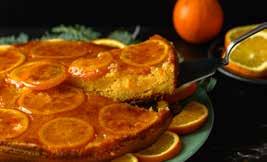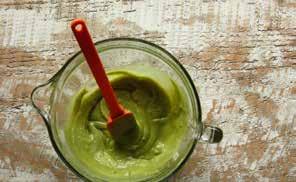
3 minute read
Food & Drink
SYRUPY ORANGE UPSIDE DOWN CAKE
by HOLLY TAYLOR, Chef at Kindling Restaurant, Brighton
Advertisement
For the oranges
• 2-3 thinly sliced oranges or blood orange • 200g sugar • 120ml water • Put the sugar and water in a large saucepan set over a medium heat • Stir to dissolve the sugar. • Add the orange slices (minus any seeds) and bring to a gentle simmer. • Once the rinds are beginning to turn translucent, remove from the heat and allow to cool. • Then layer the syrupy oranges in a pattern of your choice at the bottom of your cake tin.
For the cake
• 250g butter, softened • 250g caster sugar • ½ tsp of concentrated almond extract • 2-3 tbsp of poppy seeds (these are optional but they add a nice flavour and texture) • 5 small eggs (or four very large ones), at room temperature • 150g gluten-free self-raising flour (you can also use normal wheat-based self-raising flour) • 150g ground almonds • 2 tsp of baking powder • 30g whole milk (2 tbsp)
To make the cake
1. Preheat your oven to 160C / Gas Mark 3 and line an 8inch / 20cm round cake tin with baking parchment. 2. First, cream together your butter and sugar using a stand mixer or electric whisk. 3. When the mixture is pale and fluffy add in the poppy seeds and almond extract, then beat in your eggs one at a time 4. Sift together your self-raising flour, ground almonds and baking powder. Fold these dry ingredients into the butter and egg mixture. Once everything is well incorporated stir in the milk. 5. Spoon the cake mixture on top of the oranges and carefully level it off with a spatula. If you make a gentle indent in the middle of the cake mixture it will compensate for the rise. This helps make the top of your cake flat when it’s baked, making it a better shape when you turn it upside down. 6. Bake the cake in your preheated oven for 1 hour – 1 hour 10 mins until an inserted skewer comes out clean.
If you’re using a sprung form cake tin, I recommend baking the cake with an oven tray on the shelf underneath to catch any oozing syrup or escaping fruit juice. 7. Once your cake is baked, leave it in the tin until it’s cool to touch, then turn out upside down onto a plate or serving dish to reveal the sticky golden caramelised oranges.
HOW TO GET MORE PROTEIN INTO YOUR PLANT-BASED DIET
by ARIA BEHESHTAEIN, founder of B’liev A shift towards plant-based diets is considered necessary to tackle current environmental challenges. Additionally, a vegan diet can be a cheaper option in high-income countries such as the UK. But before embarking on a meat-free journey, think about protein, which plays a lead role in the creation and maintenance of every single cell in our bodies. It also controls hunger, helps keep blood sugar levels stable and is used in the regulation of hormones. Traditionally, meat has been considered the go-to for fulfilling our protein needs because it contains the nine essential amino acids forming what is known as a “complete protein”. But excluding meat and dairy need not be a problem. There are plant-based foods containing complete proteins—including soy, quinoa, hemp and chia—but you don’t need to consume all nine amino acids in one sitting. Your liver will store amino acids. So, by eating a combination of plant-based proteins throughout the day you can easily consume all the amino acids you need. Brown or white rice combined with beans or lentils produces a complete protein – think chilli and rice, or beans on toast. Broccoli and peas are among the superior plant protein sources. Flax seeds contain branched-chain amino acids, and they’re a great vegan source of essential fatty acids, and pumpkin seeds contain all nine of the essential amino acids.

There are plenty of protein powders available, but these can be faffy. A convenient way to top up on protein is ready-made protein shakes. Shakes are great to have in the fridge for the end of a busy day if you’re worried that you haven’t packed in enough protein. Just grab and gulp!










